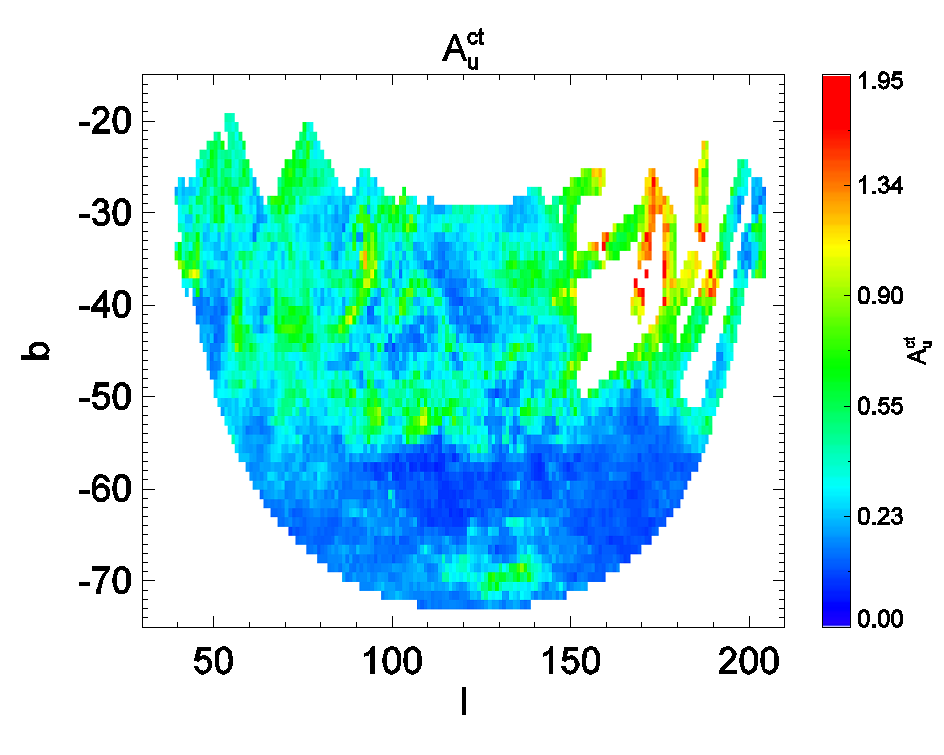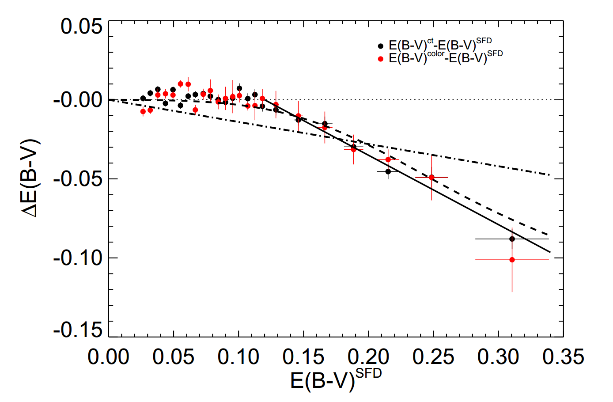The Galactic dust, i.e. dust particles inside Milky Way, absorbs and scatters photon from astronomical sources, which causes extinction and reddening in observations (Fig. 1). All the extragalactic objects are extincted and reddened by the Milky Way interstellar dust. Thus, a map of the integral Galactic dust extinction is essential for all extragalactic studies.
The most commonly used Galactic dust extinction map was constructed by Schlegel et al. in 1998(also known as SFD map, Fig. 2), which was derived from the infrared emissions of dust (measured by COBE and IRAS satellites). Due to the importance of the SFD map in extragalactic studies, it has been widely tested by many other independent measurements. Among these tests, one of the elegant way is to measure the Galactic extinction according to the cosmological principle.
The cosmological principle is also known as the Copernicus principle, which basically means that all positions in the universe are created equal. In more specialized terms, it is notion that the distribution of the matter in the universe is homogeneous and isotropic on large scales. That is to say, when we count the number of galaxies outside the Milky Way on large scales, the number of galaxies should be the same down to the same magnitude limit in all directions. Moreover, the average physical properties of the galaxies (e.g. color) should also be the same in all directions. However, due to the disk-shaped structure of the Galactic dust, the observational results in different directions don’t exhibit isotropic properties. In the direction with high Galactic extinction, the galaxies will be looked fainter and redder on average. On the other hand, if we observe the galaxies down to the same magnitude limit, the number of galaxies will be less in the direction with high Galactic extinction.
Starting from the above argument, a group of astronomers in Shanghai Astronomical Observatory have completed a systematical study on Galactic dust extinction recently. Taking advantage of the most up-to-date large sky area u band galaxy catalog from the South Galactic Cap U-band Sky Survey (SCUSS), this study has obtained statistical results with unprecedented accuracy. Currently, this study has been published in Astronomical Journal.
Their results show that the SFD map has overestimated the Galactic extinction quite significantly as high Galactic extinction region (Fig. 3). Moreover, by combing effects of the Galactic extinction (measured from galaxy number counts) and Galactic reddening(measured from galaxy color), this study further constrains the models of the Galactic extinction curve, which is determined by the physical properties of the dust particle.
Dr. SHEN Shiyin, the corresponding author of this study says, ‘the most amazing result of this study is that we can constrain the models of the Galactic extinction curve from purely statistical data. Our result gives strong supports to the classical extinction curve model of O’Donnell in 1994 and against the more recent model of Fitzpatrick in 1999. This result is attributed to the application of massive data from modern survey. This study is simple and beautiful.’

Fig. 1. A picture of Milky Way. The shadowed area shows the Galactic dust. Image from Wikipedia.

Fig 2. The all sky Galactic extinction/reddening map (also known as SFD map). Image from Schlegel et al. 1998.


Fig. 3 The Galactic extinction in south Galactic Cap region measured from galaxy number counts(left). The comparison of the independent Galactic extinction/reddening measurements with the extinction values from SFD map. The overestimation of Galactic reddening at high extinction region is clearly seen. Image from LI et al. 2017.
Link to the research paper: http://adsabs.harvard.edu/abs/2017AJ....153...88L
Science Contacts:
LI Linlin, Shanghai Astronomical Observatory, lilin@shao.ac.cn
SHEN Shiyin, Shanghai Astronomical Observatory, ssy@shao.ac.cn
News Contact:
ZUO Wenwen, Shanghai Astronomical Observatory, wenwenzuo@shao.ac.cn

